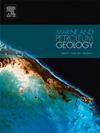Distribution and enrichment mechanism of helium in the Hetianhe gas field, Tarim basin, northwest China
IF 3.7
2区 地球科学
Q1 GEOSCIENCES, MULTIDISCIPLINARY
引用次数: 0
Abstract
Helium (He), as an irreplaceable and scarce strategic resource, is primarily extracted from natural gas for industrial and economic production. Constraining the distribution and enrichment mechanism of He in natural gas is crucial for the effectiveness of helium resource exploration and development. We report natural gas and noble gas isotopic composition in samples from three production areas in the Hetianhe He-rich gas field, Tarim Basin, northwest China. This study investigates differential enrichment of He in the Hetianhe gas field. The He content in the Hetianhe gas field ranges between 0.27% and 0.42%, with an average value of 0.33%. The He content increases gradually from east to west within the gas field and tends to accumulate in structurally high positions. 3He/4He ratios range from 0.045 to 0.076 Ra (where Ra is atmospheric ratio of 3He/4He), with an average of 0.057 Ra, indicating that the helium is typically of crustal origin. The differential enrichment of helium in the Hetianhe gas field is primarily controlled by temperature and pressure conditions, lateral migration, and preservation conditions. Changes in temperature and pressure, especially differences caused by tectonic uplift, lead to degassing, resulting in relative enrichment of helium in structurally high positions. A gas solubility model was used to quantify the subsurface fluid migration pathways and it suggests that, from the eastern production area to the middle production area and then to the western production area, the natural gas/groundwater volume ratio (Vg/Vw) gradually decreases, corresponding to 1.40, 0.35, 0.16, respectively. The Vg/Vw ratio indicates that helium-rich natural gas has undergone lateral migration from east to west. As the migration distance increases, the content of radiogenic isotopes (e.g., 4He and 40Ar) gradually increases. This suggests that during the migration, the helium-rich natural gas continuously extracts radiogenic isotopes, leading to the differential enrichment of helium. It is noteworthy that, compared to degassing, the extraction process may be the primary enrichment mechanism for helium in the Hetianhe gas field. Additionally, the distribution of east-west gypsum-mudstone cap layers results in differential vertical diffusion of helium, which macroscopically controls the differential enrichment of helium. The migration and accumulation of helium exhibit a certain synergy with hydrocarbon reservoir formation. Ultimately, a five-stage conceptual model has been developed in this study to explain the differential enrichment of helium in the Hetianhe gas field.
求助全文
约1分钟内获得全文
求助全文
来源期刊

Marine and Petroleum Geology
地学-地球科学综合
CiteScore
8.80
自引率
14.30%
发文量
475
审稿时长
63 days
期刊介绍:
Marine and Petroleum Geology is the pre-eminent international forum for the exchange of multidisciplinary concepts, interpretations and techniques for all concerned with marine and petroleum geology in industry, government and academia. Rapid bimonthly publication allows early communications of papers or short communications to the geoscience community.
Marine and Petroleum Geology is essential reading for geologists, geophysicists and explorationists in industry, government and academia working in the following areas: marine geology; basin analysis and evaluation; organic geochemistry; reserve/resource estimation; seismic stratigraphy; thermal models of basic evolution; sedimentary geology; continental margins; geophysical interpretation; structural geology/tectonics; formation evaluation techniques; well logging.
 求助内容:
求助内容: 应助结果提醒方式:
应助结果提醒方式:


